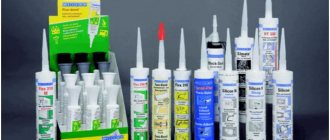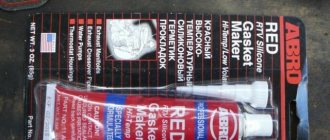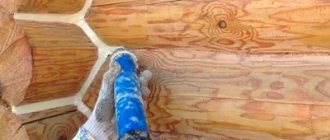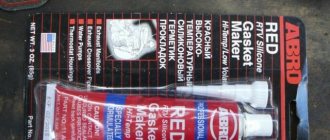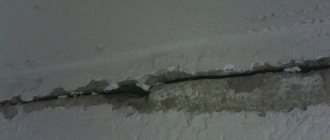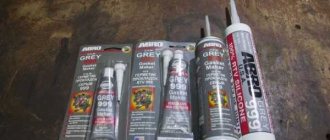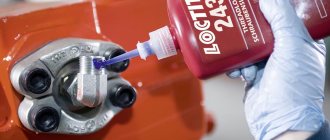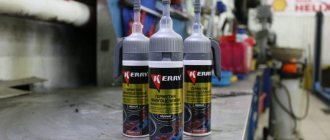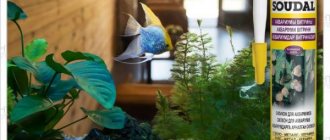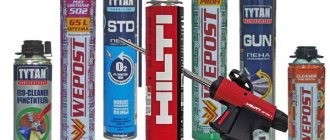The production and trading company LLC PTK Neftepromkomplekt offers a wide range of goods and services, including cold roofing bitumen mastic MBK-X. Wholesale roofing mastic MBK-X is widely used for roofing, waterproofing floors, foundations, loggias, and is also used for sealing joints and cracks.
Sealants are most often one-component, which means they are completely ready for use and do not need to be diluted with binding solutions (unlike two-component compositions). But each type has its pros and cons.
The solutions are viscous, do not contain harmful substances, and mask gaps and cracks well.
How to choose a quality sealant and what types are they?
In what cases is it necessary to protect wood with sealing materials?
Sealant is used to seal holes and defects in wood coverings and to maintain thermal insulation.
Houses, gazebos, log houses or bathhouses made of wood are very popular. But, despite the advantages of houses made of wood, there are also disadvantages.
The tree is very sensitive to temperature changes and precipitation. Due to heat or cold, the parts of the log house begin to shrink, crack, and uneven seams appear, through which heat “leaks.”
Periodically, seams and cracks need to be sealed. Previously, the gaps between the crowns of the house were plugged with anything, they used any natural material that came to hand: moss, tow, rubber, cork, jute, flax, various mastics.
But the materials did not “save” the house for long; sooner or later the wood began to rot, became overgrown with mold from the moisture that was absorbed into the fabric, flax or jute fibers, and the mastic cracked.
Wood parts dried out and became deformed, especially door jambs, the supporting system of the pitched roof (rafters), and beams in the floor.
Sealants for sealing log seams: requirements for compositions
The sealant is universal, it smooths out defects not only in the rafter system, log houses and floor coverings, but also masks gaps in window frames, cracks in steps, and is indispensable for correcting defects after exterior or exterior finishing.
Sealing compounds must meet certain requirements:
- Withstands high temperature fluctuations (precipitation in the form of snow, rain or prolonged exposure to ultraviolet radiation at temperatures of + 250°C and -45-40°C).
- They have resistance and ductility under any deformation. A high-quality composition stretches if the seams on the surface of the wood begin to diverge.
- Provide adhesion to wooden surfaces (high adhesiveness).
- They repel water from surfaces and prevent the formation of fungus or mold.
- They match the shade of wood if applied to seams and joints indoors.
It is important to check the service life - the higher it is, the better. Choosing a quality material is not so easy: most sealants have weak adhesion to wood surfaces and are not so elastic. It often happens that after the first cold snap or intense heat, the material begins to peel off from the wood.
Professional log sealing services
We employ qualified specialists with more than ten years of experience working with wood. You can entrust us with sealing the seams of your wooden house, which we will carry out in the shortest possible time and at a high professional level.
We use high-quality sealants from the world's best manufacturers. For each property, we select the optimal composition in accordance with the individual characteristics of the house. On the “Contacts” page you will find all our coordinates and you can leave your request.
Calculate the cost of painting and insulating your home right now
Select types of work:
Select materials:
What is important to know when choosing formulations
Solutions are produced in different containers: these can be plastic buckets, tubes, briquettes or tapes (the final weight of the product depends on the choice of container).
If the seams are very long, then it is better to buy sealant in the form of a tape.
When purchasing silicone joint sealants, it is important to consider that they may be of poor quality. This is not only a matter of manufacturing defects, which are also common, but also of the initial dilution of the material. Be sure to ask to see the certificate for the product.
Low cost indicates that the solution contains cheap organic compounds (kerosene, oil and other cheap diluents). Manufacturers may not indicate the presence of additives in the characteristics, which means that the label will indicate “sealant - 100%”.
But the more impurities, the lower the quality of the product - poor adhesion to surfaces, insufficient elasticity, and shrinkage over time are noted. Wood house sealant may fade or yellow.
Main colors: white, mahogany (rich brown), grey, larch and oak.
Proven brands: “Moment”, “Kvadro”, “Econ”, “Soudal”.
Disadvantages of sealants, regardless of type:
- Most repel moisture, which is a plus and at the same time a minus: due to their water-repellent properties, sealing compounds do not accept coloring pigments (the solution to the problem is a wide range of shades). High-quality sealants cannot be painted.
- Insufficient adhesion to plastic.
- Sometimes the composition “grabs” poorly and smudges in places.
Popular brands of wood sealants. What sealant to use to seal cracks and seams in a wooden house
“ Therma Chink” is durable (service life up to 30 years).
"Accent" is the best choice from the Russian manufacturer. Suitable not only for wood restoration, but also for bonding other materials (metal, brick, concrete). Durable, elastic.
The dried layer can only be scraped off with special tools (it cannot be washed off). Service life is no more than 25 years. It is distinguished by high quality and affordable cost. When compared with foreign “Perma-chink”, imported material with identical characteristics is very expensive.
For comparison:
- 19 kg of imported sealant – 34,000 rubles.
- “Accent” – 15 kg – 5500 rubles.
“Ramsauer-160-Acryl” - the paste is used to treat wooden seams and corner joints. It does not deform when shrinking, the sealant gives the effect of a “warm” seam, dries quickly (14 days is enough, but depends on weather conditions and humidity levels).
The one-component composition is easy to use (applied with a syringe). Withstands temperatures down to -43-45°C.
“Eurotex” is a world-class seam sealant based on acrylic.
Ideal for sealing wooden joints, potholes, chips and seams, does not deform during shrinkage, elastic, inhibits the formation of new cracks, masks external defects, fills voids in timber, stops the development of fungus and mold.
Application method: syringe, spatula. There is no pungent odor and can be painted decoratively. It glues well not only external timber, but also other types of wood - plywood, chipboard inside the house.
Service life is from 20 to 30 years (indoors 30 years).
“ Perma Chink ” – covers wide joints from 2-2.5 mm. Can be applied to fresh wood, suitable for indoor and outdoor use. The paste is highly flexible; you can choose many different shades (up to 10).
The optimal temperature for surface treatment is up to +30°C (minimum +5°C), it sets in two hours, it will take about 2 months until complete drying.
The approximate consumption of material depends on the width of the linear meter and the width of the gap (for 150 m you will need about 19 liters of the composition).
Most often, “ Energy - Seal ” wood sealant is chosen for exterior work - the composition is suitable for sealing narrow cracks and can withstand adverse weather conditions (maximum application temperature +30°C).
Produced in containers (325 ml) and plastic buckets (19 l). The setting time of the composition is 2 hours, complete drying is 2 months.
Spanish “ Quilosa” - the solutions are highly adhesive, cover the crown joints well, the paste does not emit an odor and does not turn yellow. More suitable for filling baseboards and wooden parquet.
PVA: glue with sawdust - easy to make yourself. The sawdust mixture is poured with boiling water, then stirred until smooth and allowed to swell. Then glue is added in parts and stirred to a viscous consistency. The solution for sealing the log house is ready.
As for the differences, perhaps the main difference between wood sealants is the country of manufacture, cost and level of plasticity.
average cost
The price of the compositions depends on many factors, such as the form of release, country of production, volume, brand, type of sealant. Average prices for different formulations are shown in the table:
| Manufacturer country | Sealant brand | Release form | Volume | Price |
| Acrylic sealants | ||||
| Germany | Remmers ACRYL 100 | Cartridge tube | 600 ml | 550 rub. |
| America | Perma-Chink | Cartridge tube Bucket | 325 ml 19 l | 1000 rub. 31,000 rub. |
| Russia | Eurotex | Bucket | 25 kg | 6300 rub. |
| Silicone sealants | ||||
| Spain | QUILOSA Sintesel Madera | Cartridge | 280 ml | 320 rub. |
| Russia | Ultima universal | Cartridge | 280 ml | 250 rub. |
| Bitumen sealants | ||||
| Finland | Makroflex | Cartridge | 300 ml | 230 rub. |
| Estonia | KRAFTOOL 41261 | Plastic tube | 300 ml | 260 rub. |
| Polyurethane sealants | ||||
| Russia | Rustil two-component | Bucket | 7 kg | 1200 rub. |
| Belgium | Soudal one-component | Cartridge | 300 ml | 450 rub. |
| Switzerland | Sikaflex Construction+ | Sausages | 600 ml | 500 rub. |
Sealant for sealing joints in a house made of rounded logs
Wood is a delicate material, so to protect the wood it is recommended to choose a warm joint sealant for wood.
Acrylic sealants with high elasticity are suitable. Then, when the logs dry out, the composition will stretch along with the wood and will not damage the surface structure.
You can use acrylic-based sealant with cellulose and latex.
Penosil or Silwood are suitable for covering deep cracks in wood. For utility rooms, it is better to use a mixture of glue and sawdust.
“Penosil” is a two-component epoxy solution that glues not only wooden but also metal parts, is waterproof, does not leave streaks, and does not contain harmful solvents.
The advantage of the solution is that after hardening, the sealant can be given any shape, parts can be cut out, painted or varnished on the surface.
Contains modifiers, plasticizers, and coloring agents. It is recommended to sand the timber before coating.
“Sylwood” is a water-based acrylic solution, elastic, wood sealant suitable for interior work (optimum temperature to start work is + 10°C).
Pros and cons of sealing a log house
Despite the fact that old methods of insulation and sealing are still popular, sealants are gradually occupying a niche of primacy.
Which is not surprising, because sealant for exterior woodwork is non-toxic, protects against the growth of mold and mildew, withstands exposure to ultraviolet rays, and at the same time retains heat and allows air to pass through (wood “breathes”).
In addition, you don’t have to remove the old putty, but apply a new layer of sealant to the old one.
As for sealing with natural materials, caulking (clogging the seams with tow, linen and other materials) can cause insects or mold to multiply inside the timber - the reason is increased humidity.
This does not apply to moss - the plant is completely bactericidal and suppresses the development of microorganisms.
The downside is that natural materials are pecked by birds and collected fibers for nests. To ensure that the house is not left without protection, moss or tow must be painted or treated with special impregnations.
Technology for sealing inter-crown seams
Before you start working, you need to prepare the surface. Remove dirt and dust from the wood with a regular cloth. Cleaning dust with a rag is suitable for a newly built wooden house. Old wood can become moldy or blackened due to moisture or large amounts of resinous substances.
In this case, easy cleaning will not be enough. If the damage is deep, you need to remove the top layer of mold with a scraper and sand the surface with a sanding machine or sandpaper. It is recommended to remove the top layer if the wood has been treated with oil solutions.
Another method of sealing log seams is abrasive-jet, non-contact. Suitable for any wood. The surface of the tree is cleaned with a jet of sand and air under high pressure. The device removes the damaged layer from the timber, revealing a natural and clean pattern on the surface.
After sanding, be sure to treat the wood with special antifungal antiseptics and varnish.
The best impregnations for treating wooden surfaces:
- “Biosept” - impregnation not only destroys mold and mildew, but also removes “blue stains” from wood and protects against insects.
- “Senezh Ultra” – protects against mold and wood-boring insects. Do not apply to drying oil, paint, varnish and water-repellent solutions.
- “Pinotex Interior” is water-based and odorless – it forms a protective film that simultaneously masks minor defects. Does not leave streaks.
- “Tikurilla” is a semi-matte coating that can be mixed with other paints. Suitable for treating rooms with high humidity.
- “Rogneda Extra” - removes mold, mildew, blue stains, but takes a long time to dry and has a pungent odor.
- “Neomid” is a water-based impregnation that protects against pests and prevents the growth of fungus, but can color the wood pale green.
Sometimes grease stains appear on the wood. They can be removed with a solvent. After treatment, the timber is washed with water and a small amount of soap solution.
The next step is to apply inter-crown insulation between the seams. The material helps reduce gaps between logs. If there is no insulation between the seams, the timber will crack over time and the walls will freeze.
Intercrown insulation reduces the drying out of the wood, prevents moisture from penetrating inside, and prevents fungus from multiplying.
Inter-crown insulation can be replaced with bundles of foamed polyethylene.
The next step is to fill the deep gaps with foam (especially if the timber diverges greatly).
Applying sealant
To work you will need:
- Spray gun.
- Water.
- Rags.
- Paint brush (narrow).
- A narrow paint spatula (it is better to choose a rounded blade).
If you are going to apply wood joint sealant for the first time, start by treating the horizontal seams between the logs. Leave the timber joints for last.
Wipe the seam with a rag soaked in water. The rag should be damp, but not wet - drops of water should not flow down the frame, otherwise the adhesion to the surface will be impaired.
Check that no dirt or dust remains in the gaps.
Fill the construction gun with sealant, cut off the tip of the device (the cut angle should be no more than 45°C, and the diameter should not be more than 5 mm).
Wood sealant can be diluted in a separate bucket or a jar of solution can be attached to a syringe.
Press the tip of the spray gun close to the seam, and carefully squeezing out the composition, smoothly walk along the strip to the very end.
Don't rush - you don't need to release too much paste into the gaps (the thickness should be no more than 6 mm).
Smooth out the sealant strip. Pressure on the spatula should be light. If you press too hard, the layer will be too thin and may break after curing.
Excess solution must be removed with a rag before the sealant hardens. Some craftsmen remove the excess with a spoon and smooth the surface of the seam. Then use a rag to remove any rough edges from the seam.
The peculiarity of color compositions is that the shade is not immediately visible; you need to wait some time before it appears (usually no more than 10 days). During the first 4-5 days, it is important to ensure that the wood does not get wet.
Sealing seams and cracks
Cracks in wood appear for various reasons:
- Natural shrinkage of a log over time (usually seasonal).
- Mechanical deformations.
- Pressure on the beam.
Putty for filling cracks and chips can be one-component - based on one composition (usually alkyd), or two-component - when you need to mix putty and hardener. If the gaps are very deep, it is better to choose two-component compounds; they are more durable, flexible and do not shrink.
Wood glue and sawdust are used to cover small cracks.
You can repair cracks, chips and level the structure of wood with epoxy resin - once it hardens, the substance turns into plastic.
Cracks in logs need to be cleaned and all accumulated debris removed. The most effective cleaning method is a compressed air device (it is better to contact a cleaning company).
Place strips of masking tape along the edges of the cracks - this way, after removing the strips, the edges will remain smooth and the sealant will not come out beyond the seam.
Insert a thin strip of insulation inside the crack (depth up to 10 mm). Apply a layer of paste from a syringe on top of the strip, remove excess with a spatula (to easily remove excess, the spatula should be moistened in water).
Carefully remove the strips of tape.
It remains to wait until the solution hardens completely.
Restoration of potholes and chips is recommended to be carried out no earlier than 1-2 years after the construction of the house. The reason is that you need to wait until the house shrinks (cracks can expand several times).
Note: cracks up to 5 mm wide do not require repair.
Recommendations for the selection and use of sealant
You should not dilute the sealant for the log house with plain water; it may lose all its properties (delaminate and lose adhesion to surfaces).
Do not buy sealants weighing more than 340 g and with damaged packaging (frayed label, chips, dents).
Buying sealant in large containers will help save up to 15-20% of the solution, but provided that the paste is completely used.
20 liters of solution is enough to lubricate a maximum of 140-150 m of seams up to 2 cm wide, if the gaps are additionally covered with strips of insulation.
Do not trust the labeling - the inscription “100% silicone” most often indicates that the composition contains many additional impurities that negatively affect the quality of the material.
Acrylic-based compositions are not recommended for use for exterior decoration - they will not withstand low temperatures.
For covering wooden surfaces, it is better to choose colorless pastes.
To enhance adhesion to surfaces, before applying the paste, the seams are lubricated with a primer.
If moisture constantly accumulates in the room or is subject to high temperature changes, choose materials with fungicides in the composition (suitable for lubricating cracks on balconies and tiles in shower stalls).
For roofing, use bitumen pastes.
You should know that if the container with the solution is stored in cellars with sub-zero temperatures, the paste will be thick and will not adhere well to the seams.
It’s okay if the solution in plastic containers is frozen - it can be thawed at room temperature and used again. But do not speed up the defrosting process and do not place plastic buckets with the composition on hot heating pipes.
When is it needed for a log house?
Log structures are susceptible to destruction over time. The initial stage manifests itself in :
The appearance of cracks in the material.
This happens when under-dried logs are used. The wood shrinks unevenly. Remaining moisture accumulates inside, cracks and crevices begin to form. Water gets into the cracks and stagnates inside. This leads to rotting and destruction of the log.- Age-related changes in the material. Over time, wood loses its technical properties.
- Formation of gaps between the cylinders. If gaps appear between the logs, this leads to heat loss in the room.
If there are drafts in the house, the room does not retain heat, or cracks in the walls are visually visible, then it is necessary to carry out work to seal the log house. First of all, it is recommended to repair minor damage and cracks that have just begun to appear.
What is included in low quality sealants?
Low-grade solutions contain vinegar essence and solvents. The disadvantage of such solvents is that they destroy lignin (a polymer of natural origin, a product of biosynthesis) and cellulose. It is cellulose and lignin that are responsible for the surface layer of wood and its strength.
After application and drying, wood sealant may peel off over time (craftsmen often find that the strips completely fall off the frame and the seams have to be re-sealed).
Solvent and vinegar essence are often found not only in silicone pastes, but also in other sealants. The safest option is acrylic mixtures.
Hybrid and polyurethane materials are not cheap, but often do not live up to expectations.
But this does not mean that sealants at a low price are better - if you are offered a product at a reduced cost, this should alert you.
Briefly about the main thing
Silicone sealant is used as an elastic, moisture-proof filler for seams and joints between mineral, wood, plastic, metal, and glass substrates.
The limitation of relatively weak adhesion is polymeric materials.
Manufacturers use various additives that affect the technical characteristics of the finished product and its scope of application.
There are silicone sealants that are acceptable for use as moisture-resistant adhesives.
Ratings 0
Current issues
See also
Decorative plaster coat: do-it-yourself application technology
There are several common questions that are associated with this insulation and insulation technology.
I'll try to answer them.
- Is there any point in using sealant if the joints are caulked? Yes, it makes sense. The efficiency of insulation will be much higher;
- When is the best time to remove excess? This needs to be done right away. It is undesirable for the sealant particles to dry on the wood. This can ruin the appearance of the walls when scraped. It is better to moisten dried residues with warm water and then rinse with a rag. Do not use abrasives;
- Which side is better to apply a warm seam? It is best to apply the composition on both sides. So the quality of waterproofing will be much higher;
- What compound should I use to treat internal seams? It is believed that any sealant is suitable for these purposes. Not certainly in that way. It is better to use acrylic composition. It is the safest and also environmentally friendly;
- At what temperature is work carried out? Here, each composition has its own limitations. You need to read the instructions. But in general, single sealants allow you to work in cold weather. One of them is Accent 136.
Yes, indeed, many orders had to be completed in winter. And the seams were sealed with Accent.
Types of packaging
Special attention should be paid to the packaging options for sealants. Regardless of type, these drugs are available in several form factors. When choosing between them, you should focus only on personal preferences and benefits (large containers are cheaper if you need a lot of sealant).
| Type of packaging | Peculiarities |
| Tuba | The sealant is squeezed onto the seam directly from the tube, and then shaped and leveled with a chisel. But you have to work quickly - within 10 minutes the polymerization process begins, the sealant becomes harder and more intractable. |
| Bucket | In this case, the sealant is manually scooped onto a spatula and applied to the wood. |
| Box | Often equipped with a lid, which simplifies the work with the spatula. Sometimes there is an “adapter” to put the sealant into the caulk gun. |
| Cartridge | Specially shaped to be inserted into the gun. |
| Foam cord | Sold in rolls. It is used according to the principle of caulking with jute - the cord is driven into the crack with some hard tool. |
Types of "warm seams"
For natural wood species we offer:
- Products based on silicone acid or neutral, the service life of which is about twenty-five years. Taking into account the fact that they cannot be painted, manufacturers offer a wide range of ready-made multi-colored mixtures to choose from;
- Polyurethane-based compounds have good adhesion along with optimal strength, while having a higher cost. Such mixtures are not afraid of moisture, exposure to chemicals, or mechanical stress. They can be painted in the color of your choice, however, as regards fading in the sun, their resistance is considered insufficient;
- The most commonly used in practice are acrylic sealants, which provide excellent adhesion due to their environmentally friendly, non-toxic components, which is important for the porous structure of wood. It is usually painted "wood" after polymerization.
It is necessary to give preference to only proven brands.
